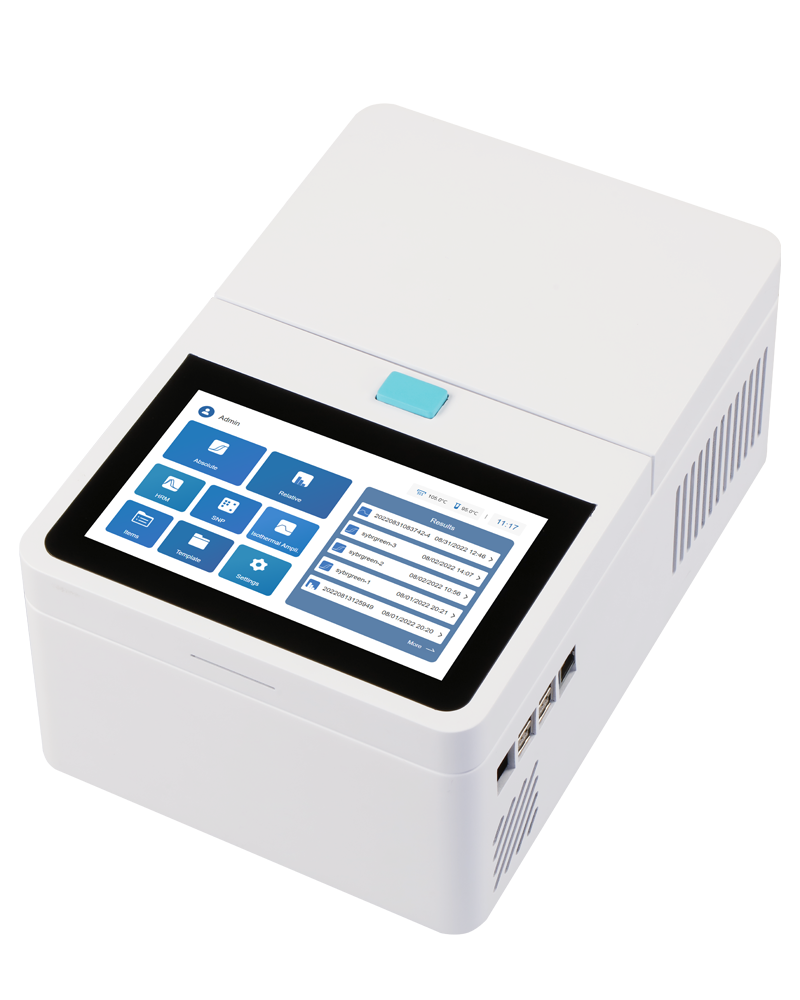01 What is the difference between conventional PCR and fluorescence quantitative PCR?
PCR: A method of rapid expansion of specific target nucleic acid fragments in vitro. It is usually composed of degeneration -annealing -extension three basic reactions steps, and the target nucleic acid amplification is achieved through the circulation of different temperatures.
Real-time qPCR: It is a nucleic acid/gene detection technology developed on the basis of PCR technology. It is a kind of fluorescent marking probe or fluorescent dye to the PCR reaction system. By collecting the subsequent order of fluorescence signals and changes in strength, with software analysis CT value and standard curves, It’s qualitative or quantitatively analyzed for the purpose gene.
02 What are the composition of fluorescence quantitative PCR reaction system?
Fluorescence quantitative PCR reaction system includes: nucleic acid templates, primers, thermal stabilization DNA polymerase, four types dNTP, fluorescent dyes or Taqman probes, and buffer containing Mg2+. The reaction system of volume 20 μL or 50 μL is generally configured.
Nucleic Acid Template
Generally with 20 μL reaction system, the use of the template is less than 100 ng. When the reverse transcription product is used as a template, the template volume does not exceed 20% of the final volume of the system. Reversal transcription experiments with template, which are commonly used in genetic expression detection. During the material collection process, the sample needs to immediately freeze liquid nitrogen and quickly transfer to ultra-low temperature refrigerators to avoid RNA degradation. Generally, the experimental materials are divided into the control group and processing group. There should be more than 3 groups of repetition in the group, so that the data with large deviation can be processed later.
DNA Polymerase
When performing fluorescence quantitative PCR experiments, the appropriate heat-resistant polymerase needs to be selected, specifically referring to the specificity, preservation, heat resistance, amplification rate and other indicators of the enzyme. At present, the Taq DNA polymerase is more commonly used on the market, and there are many other types of DNA polymerase, such as Vent series, KOD series and Pfu series.
Primer
It refers to two synthesis oligonucleotide sequences. One primer complements the base at the 3 'end of the target region of the corresponding DNA template chain, and the other primer complements the base at the 5' end of the target region of another DNA template chain.
dNTP
dNTPs is a general name for dATP, dGTP, dTTP, dCTP. dNTPS, as a DNA replication raw material, directly affects the yield, specificity, and preservation of the amplifier product. Therefore, reagents with accurate concentration and high purity need to be selected during the experiment.
Buffer Solution
The role of buffer solution is to provide a suitable chemical environment for DNA polymerase activity. Usually buffer solution pH is 8.0~9.5, changing pH will affect nucleic acid amplification. In addition, Mg2+, the key component of buffer solution, is an ion necessary for enzyme work. It is compatible with dNTPS and templates to become a substrate for DNA polymerase recognition. At present, the commonly used buffer solution on the market is generally 2× concentrated solution, which can be configured according to the addition of the instructions.
Fluorophore Group
Fluorescent chemicals can be divided into fluorescent dyes and fluorescent probes.
Fluorescent dye, represented by SYBR Green, bind nonspecific to the DNA groove region. When a double chain is formed, and the dye binds to the double stranded DNA. The dye is excited by the light source to generate fluorescence signal, and the intensity of fluorescence signal is proportional to the number of DNA double strands.
The luminous mechanism of the fluorescent probe is different from the dye. It uses a pair of groups that can generate fluorescent resonance energy transfer, that is, the report group of 5 ′ end and the quenching group of the 3 ′ end. When the probe is complete, the fluorescence signal of the reporting group is quenched by quenching the group. During amplification, the 5 ' -end enzyme activity will hydrolyze the probe, the reporting group is separated from the quenching group, and the fluorescent signal begins accumulation.
Fluorescent group | Fluorescent dyes | Fluorescent probe |
Common reagent | SYBR Green I | FAM, TET, HEX, etc. |
Specificity | No specificity for DNA | Probe specifically binds to DNA |
Sensitivity | Low sensitivity, suitable for gene quantification with large number of copies | High sensitivity, suitable for detecting micro gene products or micro RNA |
Target fragment | Detection of a target fragment with the same reaction | Simultaneous detection of multiple target fragments with the same reaction |
Cost | Low | High |
In general, fluorescence quantitative PCR is used as a common detection method for nucleic acid quantification. The system configuration is simple and the scope of applications is wide. When performing qPCR experiments, the detection method is effective whether you choose fluorescent dyes or fluorescent probes. You can choose the appropriate method according to your own materials.

Esan-Gene 162/164

 Biological Sample Preparation
Biological Sample Preparation
 Life Science Detection Products
Life Science Detection Products
 POCT Detection & Reagent
POCT Detection & Reagent
 Automation & Liquid Handling
Automation & Liquid Handling
 Laboratory Instrument
Laboratory Instrument
 Reagent & Consumable
Reagent & Consumable
 Others
Others
 OEM/ODM
OEM/ODM












 Release time:2022-10-28
Release time:2022-10-28
 Source:
Source:
 Pageviews:3330
Pageviews:3330










 + 86 571-88859758
+ 86 571-88859758 sales@allsheng.com
sales@allsheng.com



